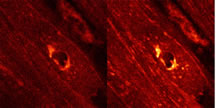 Photonics is facilitating revolutionary advances in the life sciences, biotechnology and medicine, and the emerging field of biophotonics is widely expected to deliver major scientific and commercial rewards. A co-ordinated programme drawing on Scotland’s manifest strengths in key photonics areas such as optical manipulation, multi-photon and spectral imaging, time-resolved fluorescence, as well as non-linear techniques and sensor technologies is strategically important in achieving the goal of global competitiveness. New permanent posts and SUPA Fellowships will play a key role in this initiative area.
Photonics is facilitating revolutionary advances in the life sciences, biotechnology and medicine, and the emerging field of biophotonics is widely expected to deliver major scientific and commercial rewards. A co-ordinated programme drawing on Scotland’s manifest strengths in key photonics areas such as optical manipulation, multi-photon and spectral imaging, time-resolved fluorescence, as well as non-linear techniques and sensor technologies is strategically important in achieving the goal of global competitiveness. New permanent posts and SUPA Fellowships will play a key role in this initiative area.
 The links within SUPA are a major advantage and the strong cross-disciplinary collaborations with the life science and medical community both locally and internationally are being enhanced and extended. Microscopy is a key enabling tool where strong expertise exists and where there is great potential for radical approaches to innovation. Leading biological microscopy techniques (Strathclyde) when combined with optical tweezers (St Andrews, Glasgow, Edinburgh) for the positioning of particular objects within cellular structures, open new opportunities for fundamental life science research. For in vivo sensing and imaging, fluorescence is a major technique where leading expertise in lifetime measurements (Strathclyde, Edinburgh) and sensing (Glasgow). The Heriot-Watt and Edinburgh groups are constructing a multi-planar imaging microscope employing diffractive optics and ultra-high collection efficiency to produce 3D position data at a resolution of a few 10’s of nm. Following human genome mapping, the aim of future genomics/proteomic assay research is to determine the function of genes and their role in the protein synthesis. The integration of micron sized sources and nano-optics (Strathclyde) with single photon (quantum dot) sources and detectors (Heriot-Watt) will provide the tools needed for radical advances to in such instrumentation. The concept of a “physics lab on a chip” can thus be moved several steps closer to reality.
The links within SUPA are a major advantage and the strong cross-disciplinary collaborations with the life science and medical community both locally and internationally are being enhanced and extended. Microscopy is a key enabling tool where strong expertise exists and where there is great potential for radical approaches to innovation. Leading biological microscopy techniques (Strathclyde) when combined with optical tweezers (St Andrews, Glasgow, Edinburgh) for the positioning of particular objects within cellular structures, open new opportunities for fundamental life science research. For in vivo sensing and imaging, fluorescence is a major technique where leading expertise in lifetime measurements (Strathclyde, Edinburgh) and sensing (Glasgow). The Heriot-Watt and Edinburgh groups are constructing a multi-planar imaging microscope employing diffractive optics and ultra-high collection efficiency to produce 3D position data at a resolution of a few 10’s of nm. Following human genome mapping, the aim of future genomics/proteomic assay research is to determine the function of genes and their role in the protein synthesis. The integration of micron sized sources and nano-optics (Strathclyde) with single photon (quantum dot) sources and detectors (Heriot-Watt) will provide the tools needed for radical advances to in such instrumentation. The concept of a “physics lab on a chip” can thus be moved several steps closer to reality.
 |
 |
